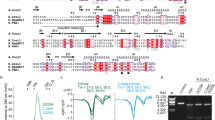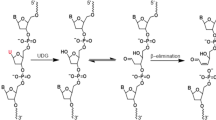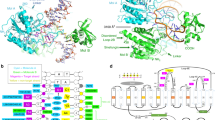Abstract
MISPAIRS in DNA of guanine with uracil and thymine can arise as a result of deamination of cytosine and 5-methylcytosine, respectively. In humans such mispairs are removed by thymine-DNA glycosylase (TDG)1–3. By deleting the carboxy and amino termini of this enzyme we have identified a core region capable of processing G/U but not G/T mispairs. We have further identified two bacterial proteins with strong sequence homology to this core and shown that the homologue from Escherichia coli (dsUDG) can remove uracil from G/U mispairs. This enzyme is likely to act as a back-up to the highly efficient and abundant enzyme uracil-DNA glycosylase (UDG) which is found in most organisms. Pupating insects have been reported to lack UDG activity4, but we have identified an enzyme similar to dsUDG in cell lines from three different insect species. These data imply the existence of a family of double-strand-specific uracil-DNA glycosylases which, although they are subservient to UDG in most organisms, may constitute the first line of defence against the mutagenic effects of cytosine deamination in insects.
This is a preview of subscription content, access via your institution
Access options
Subscribe to this journal
Receive 51 print issues and online access
$199.00 per year
only $3.90 per issue
Buy this article
- Purchase on Springer Link
- Instant access to full article PDF
Prices may be subject to local taxes which are calculated during checkout
Similar content being viewed by others
References
Neddermann, P. et al. J. Biol. Chem. 271, 12767–12774 (1996).
Wiebauer, K. & Jiricny, J. Nature 339, 234–236 (1989).
Neddermann, P. & Jiricny, J. Proc. Natl Acad. Sci. USA 91, 1642–1646 (1994).
Dudley, B., Hammond, A. & Deutsch, W. A. J. Biol. Chem. 267, 11964–11967 (1992).
Neddermann, P. & Jiricny, J. J. Biol. Chem. 268, 21218–21224 (1993).
Wang, Z. & Mosbaugh, D. W. J. Biol. Chem. 264, 1163–1171 (1989).
Mol, C. D. et al. Cell 80, 869–878 (1995).
Sawa, R., McAuley Hecht, K., Brown, T. & Pearl, L. Nature 373, 487–493 (1995).
Seeberg, E., Eide, L. & Bjoras, M. Trends Biochem. 20, 391–397 (1995).
Varshney, U. & van de Sande, J. H. Nucleic Acids Res. 17, 813 (1989).
Duncan, B. K. J. Bacteriol. 164, 689–695 (1985).
Deutsch, W. A. Insect. Mol. Biol. 4, 1–5 (1995).
Morgan, A. R. & Chlebek, J. J. Biol. Chem. 264, 9911–9914 (1989).
Schneider, I. J. Embryol. exp. Morph. 27, 353–365 (1972).
Wiebauer, K. & Jiricny, J. Proc. Natl Acad. Sci. USA 87, 5842–5845 (1990).
Tomilin, N. V. & Aprelikova, O. N. in International Review of Cytology (eds Bourne, G. H., Jeon, K. W. & Friedlander, M.) 125–179 (Academic, San Diego, 1989).
Duncan, B. K. & Weiss, B. J. Bacteriol. 151, 750–755 (1982).
Ausubel, F. M. et al. Curr. Prot. Mol. Biol. (Wiley, New York, 1995).
Author information
Authors and Affiliations
Rights and permissions
About this article
Cite this article
Gallinari, P., Jiricny, J. A new class of uracil-DNA glycosylases related to human thymine-DNA glycosylase. Nature 383, 735–738 (1996). https://doi.org/10.1038/383735a0
Received:
Accepted:
Issue Date:
DOI: https://doi.org/10.1038/383735a0
This article is cited by
-
Uracil-DNA glycosylase efficiency is modulated by substrate rigidity
Scientific Reports (2023)
-
Replication-coupled passive DNA demethylation for the erasure of genome imprints in mice
The EMBO Journal (2012)
-
DNA glycosylases: in DNA repair and beyond
Chromosoma (2012)
-
SUMO-1 regulates the conformational dynamics of Thymine-DNA Glycosylase regulatory domain and competes with its DNA binding activity
BMC Biochemistry (2011)
-
Embryonic lethal phenotype reveals a function of TDG in maintaining epigenetic stability
Nature (2011)
Comments
By submitting a comment you agree to abide by our Terms and Community Guidelines. If you find something abusive or that does not comply with our terms or guidelines please flag it as inappropriate.



